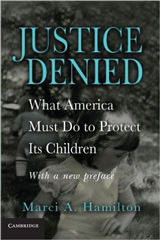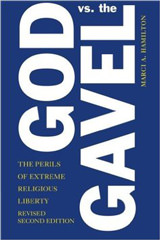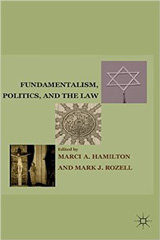The latest sex abuse scandal in the headlines paints USA Gymnastics in as bad a light as you can imagine. Indeed, it is so bad the successful president of the organization, Steven Penny had to resign. This scandal, amidst a series of other sports scandals, has pushed the U.S. Olympic Committee to create a new board to investigate claims of sex abuse, SafeSport, and Sen. Dianne Feinstein, with bipartisan support, to introduce the Protecting Young Victims from Sexual Abuse Act. The latter mandates that anyone who suspects abuse in a National Governing Body (NGB) of an Olympic sport must report the suspected abuse to the authorities, extends the statute of limitations for civil suits against perpetrators, bans one-on-one time between coaches and athletes, and imposes other specific requirements on NGBs.
These are important developments that we can only hope will make elite sports safer for children, a need I discuss here. At the same time, bells should be ringing. We have been here before. These Olympic sports-related developments should bring to mind the Roman Catholic Bishops’ Dallas Charter, which established a new “zero-tolerance” policy for abuse in the church following a scandal of huge proportions. The same is true for the Boy Scouts and countless of other organizations. As each of these silos of abuse has been disclosed, organization-specific policies have sprouted.
It is now time to connect the dots between the scandals.
When Sex Abuse Was Not Reported and the Perpetrators Were “Mr. Stranger Danger”
There was a time when sex abuse was rarely reported. It is impossible to measure how much of the silence was due to denial and how much ignorance, but to be sure the combination kept it buried, and the victims were locked away in a closet of silence. No one, least of all the media, wanted to discuss it. Those stories that made it into the newspapers were literally unavoidable, like the prosecution of Fr. Gauthier in Louisiana for the sex abuse of numerous boys in the early 1980s.
With the reporting of sex abuse being sporadic at best, it was nearly impossible to see the patterns of cover up within various organizations. The mass assumption was that the Gauthier case was unusual, and so were the few other cases that bubbled up into the media on occasion. These were distinct data points and there was no reason to suspect that anyone was responsible for the abuse other than the perpetrator, who was a lone wolf monster preying on children. We were so uninformed that we even called the predators “Mr. Stranger Danger,” signaling he was outside the child’s circle of family, school, and extra-curricular activities.
The Organizational Scandals Appear on the Horizon
Then there was the Spotlight investigative team at The Boston Globe and other reporters like Marie Rhode at the Milwaukee Journal Sentinel, who started to dig into the issue in the Roman Catholic Church. A diocesan-based pattern surfaced in 2002 as these hard-working reporters connected the dots. Here is what they saw to their horror: the perpetrators were not acting alone. Rather, bishops covered up seriatim sex abuse by their priests. Then there was Penn State and Jerry Sandusky, with striking similarities. Once the paradigm was visible, the same dynamic was seen at work in many other organizations as well
The response was outrage, from those inside the organization to prosecutors to the general public. How could these trusted leaders let this happen? Everyone agrees this is the most despicable of crimes and that anyone who allows it to happen is no better than the direct perpetrator. They also agree that this must be excised from our social fabric. But how? For most, the answer has been: just make it stop. Now. It’s as though we discovered someone we knew maliciously beating a stranger and all we needed to do was pull him off and then we could just walk away, whistling in the wind.
The unveiling of the paradigm made it possible to see that the perpetrator was very often a beloved figure in the child’s world and that leaders put children at risk, not just perpetrators. As I discuss above, at the point at which the paradigm surfaces from within a new organization, it pledges to do better by crafting its own child protection policies and trumpeting its better child protection policies to the public. (If one more organization announces after its first round of reform that it is the safest place for children ever . . .)
Still, the problem is redressed in silos, with individual arenas working distinctly from all others. An assumption is built into that reasoning: each child sex abuse scandal is different and needs distinctive policies tailored to its arena. So the bishops need theirs and the USOC its own, as do the Boy Scouts. That gives rise to leadership whispering amongst itself, “Well, at least we’re not as bad as they are.” Or, “We are much more likely to solve this problem than they are, because we are different—and, really, better.” This is a mistake.
By Treating Sex Abuse Differently, Organization-by-Organization, We Fail to Achieve the Child-centered Policy That Will Protect Children Adequately
When organizations jump in to solve their own problems, and do not join a society-wide push to end child sex abuse in every arena, it perpetuates the prioritization of the organization over the children, which puts children at greater risk in the first place. So long as the focus is on the organization and its “needs” children will lose.
Why? Because child sex abuse is as old as humankind and just as entrenched. These institutional scandals are not intrinsically different but rather symptoms of a larger society-wide problem: Children have been property and sexual fodder for adults in every single arena, including and mostly, the family. Transforming them from their sexual property status to rights-holding human beings takes a seismic culture shift—and I don’t mean it takes a village, or a country. I mean it takes a disruption in the subterranean stratum that constructs the society’s entire relationship between children and adults.
This tectonic shift cannot happen when discrete organizations are left to their own devices, no matter how good their intentions, because unaccountable organizations (and that is what an organization governing itself is) will devolve into scenarios of self-protection and adult preferentialism. The law has set up organizations to these ends, actually: The boards of directors have fiduciary obligations to the organization, the leadership is awarded for its success for the organization, and the fans of the organizations have an insatiable appetite for its public achievements. When you add to that the ingrained tendency of adults to put adult interests like reputation and career ahead of children, the result is that children continue to be institutionally incapable of overcoming these biases against protection.
Enough Institution-by-Institution Scandals: It’s Time for the Government to Act
When organizations cannot be trusted to act in the public good, the government must step in. There are already criminal laws applicable to the individual perpetrators aplenty. But current law is woefully inadequate to hold the institutions to account. Other than civil lawsuits for damages against the individual organization, which are typically blocked by statutes of limitations and all manner of employer-favoring rules that shield them from true accountability. What is needed is a law that mandates certain principles and practices for every organization involved in any way with children: let’s call it the Base Line Law to Protect Children. Its provisions can be simple, but because they are enforced by the government, rather than internally, they can permanently make a difference. So what are the basics?
- Every adult who suspects a child is being sexually abused must report it to the authorities before reporting it to the organization—whether or not the relevant state’s law requires it. This move takes the issue out of the self-referential center where organizational self-interest thrives.
- No adult, other than a parent or guardian, may be alone with a child in a closed space in the performance of the organization’s mission. This means, for example, a classroom, an examination room, a bathroom, or a car. Doors need to be open, meetings must be visible to passersby, and organizations need to plan to have two adults on hand in many circumstances.
- No adult who has sexually abused a child may have a leadership role in the organization. Ever.
- Every adult affiliated in any way with the organization must be trained annually on spotting sex abuse, how to report, and dealing with children who have been abused.
- Every child affiliated with the organization must be trained annually on spotting sex abuse, how to report, and respecting their cohorts who have been abused.
- Penalties need to be severe for failure to follow these modest but necessary principles to child protection.
- No organization is exempt, whether religious, or otherwise.
The trick with organizations is that they often change leadership and, let’s face it, organizations are really just legal fictions. In fact, they are collections of individuals. But the prosecution of individuals for the organizations’ sins has been singularly unsatisfying, as the prosecution of Msgr. William Lynn in Philadelphia attests. He was a mid-level church official who definitely endangered children as he followed orders—but he was just mid-level. The Cardinals and Archbishops of Philadelphia who so callously endangered children in their diocese were left off the hook, and we all know who was in control. While the prosecution of Lynn was groundbreaking, he is in the end a small fish. It doesn’t scare the men in charge.
This reality means that the best legal format to pursue these organizations is through the RICO model, which was crafted to deal with organized crime, because responsibility for criminal behavior by those at the bottom was orchestrated by those at the top. When it comes to sex abuse, the conditions that lead to the sex abuse of children are often created by management, from bishop to organizational president to board or hierarchy. Until the organizations—through those in charge—are held to account and forced to make child protection a priority even when inconvenient, children are at risk.
That, in turn, is not barrier-free. The current federal civil RICO would need to be amended to make it applicable to child sex abuse and should be. The criminal federal RICO could be applied, and should be. That takes visionary US Attorneys who make child protection, regardless the setting, a priority.
Now, you may fairly say that my proposal still treats organizations as organizations and so how does it further my goal of pushing past the silo approach to child protection. The answer is that it forces organizations to look beyond their confines and to be accountable to principles that govern them regardless of how they differ in their importance, history, or power from the others. When it comes to covering up sex abuse, they are—and they need to understand that they are—all the same.










First of all, I would like to thank Marci Hamilton for her outstanding efforts on behalf of children who were sexually abused by adults who were in positions of power. There has been tremendous progress made over the last thirty years in making this subject something that nobody talked about into a subject that is discussed on a daily basis. But sadly, talking about a subject does not make it go away. Australia, with its’ Royal Commission has become the model for the world to follow and hopefully emulate in how to deal with organizations that treat children as second class citizens. I was twelve when I was sexually molested by a Catholic priest after serving Mass back in 1961.The effects on my life have been horrible. No child or adult abused as a child should have to go through what I have.
By the time that the alleged “victims” come forward, often in collective, copy cat style, the statute of limitations for criminal prosecution has long, long since run out. That is part of the problem.